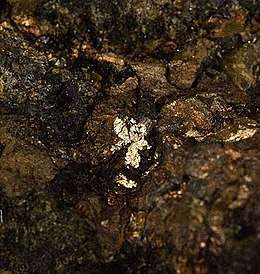Valleriite
Valleriite is an uncommon sulfide mineral (hydroxysulfide) of iron and copper with formula: 4(Fe,Cu)S·3(Mg,Al)(OH)2[3] or (Fe2+,Cu)4(Mg,Al)3S4(OH,O)6.[2] It is an opaque, soft, bronze-yellow to brown mineral which occurs as nodules or encrustations.
| Valleriite | |
|---|---|
 Cubanite (brass yellow), maucherite (dark gray) and valleriite (dark bronze), mainly. | |
| General | |
| Category | Sulfide mineral |
| Formula (repeating unit) | (Fe2+,Cu)4(Mg,Al)3S4(OH,O)6 |
| Strunz classification | 2.FD.30 |
| Dana classification | 2.14.1.1 |
| Crystal system | Trigonal[1] |
| Crystal class | Hexagonal scalenohedral (3m) H-M symbol: (3 2/m) |
| Space group | R3m |
| Unit cell | a = 3.79, c = 34.1 [Å]; Z = 2 |
| Identification | |
| Color | Bronze-yellow, gray |
| Crystal habit | Massive, nodular, encrustations, thin splintery |
| Cleavage | Excellent on {0001} |
| Mohs scale hardness | 1 - 1.5 |
| Luster | Metallic |
| Streak | Black |
| Diaphaneity | Opaque |
| Specific gravity | 3.14 (measured) |
| Pleochroism | Strong; pale yellow to deep brown |
| References | [2][3][1] |
Discovery and occurrence
Valleriite was first described in 1870 from an occurrence in Västmanland, Sweden. It was named for Swedish chemist Johan Gottschalk Wallerius (Vallerius) (1709–1785).
Valleriite occurs in dunites and chromitites replacing chalcopyrite in Cyprus. In Phalaborwa, South Africa it occurs as replacement of magnetite in a carbonatite. It occurs as replacements of copper and nickel phases in serpentinites and other altered ultramafic rocks.[3]
gollark: Well, they might, but Lua doesn't have support for them.
gollark: How do you just "go around" vertices?
gollark: This paper on hyperbolic tilings was very confusing.
gollark: Oh, right, I remember why apiogame was inevitably abandoned now.
gollark: Not currently.
This article is issued from Wikipedia. The text is licensed under Creative Commons - Attribution - Sharealike. Additional terms may apply for the media files.